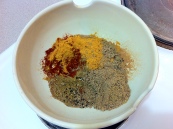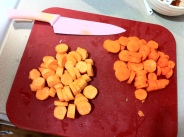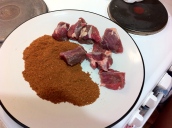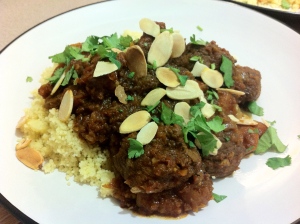Moroccan cooking
A history of Morocco is incomplete with the inclusion if the Berber people. They are the indigenous people of North Africa whose homeland includes the Kingdom of Morocco. Even during the Byzantine Empire, the Berber people remained mostly independent from rule in large part due to the fact that many of them inhabited the area in and around the Atlas Mountains, which separate the Atlantic Coast of Morocco with the Sahara Desert. You can see a bit of what the Berber people are like as well as hear some traditional music in the video below!
However, the story of Morocco actually begins with the demise of the Berber way of life. Although these particular Berber clans were Muslim, they didn’t follow it too seriously at times and retained their traditional Berber customs. This changed in the 11th century, because of a man named Abdallah ibn Yasin. Yasin was a strict follower of Islam. He became a preacher who aimed to change the Berbers into proper fundamentalist Muslims. The tribes of Western Sahara joined him, and he led them on a jihad through Northern Africa and even into parts of Spain and Portugal.
This rule continued through various dynasties throughout the next few centuries until the early 1900′s, when French and Spanish were granted protectorate status by the Treaty of Fez in 1912. Their reign over much of Morocco would include exploitation of many of the countries natural resources, as well as many human rights violations. The French did everything in their power to insure that Morocco could not gain independence, including exiling a popular leader and replacing him with what the Moroccan people perceived to be a puppet. This lead to a Moroccan uprising in 1955 and Morocco eventually gaining it’s independence on August 20, 1956.
It is interesting to know that Morocco was the first Nation to recognize the United States as an independent nation in 1777. Another interesting bit of trivia is that the Moroccan-American Treaty of Friendship is the longest unbroken treaty in U.S. history..
Morocco remains the only African state not to Be a member of the African Union, mostly due to disputes over Western Sahara (an area which it claims but has been disputed). The UN has not recognized Western Sahara as an independent nation, and several military conflicts have happened in recent history.
I could go on for ages…bu we are here to cook as well!
The Recipe: Lamb Tajine with Couscous (Serves 4-5)
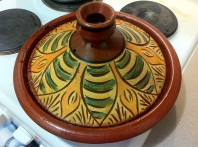 Today we are going to cook what I would consider the most popular of Moroccan dishes, the Tajine. Historically a Berber dish, we will also keep it as authentic as possible by serving it with Couscous. The Tajine is a dish named after the pot in which it is cooked. However if you are not as lucky as us to own a Tajine, it is acceptable to use other forms of cookware to make this dish, such as a casserole dish, a crock-pot or a Dutch oven. this recipe, like many Moroccan dishes, is full of spices, which are used extensively in Moroccan cooking. This is a take on a traditional lamb tajine, but it should be noted that there are literally thousands of ways you can modify this dish to your liking.
Today we are going to cook what I would consider the most popular of Moroccan dishes, the Tajine. Historically a Berber dish, we will also keep it as authentic as possible by serving it with Couscous. The Tajine is a dish named after the pot in which it is cooked. However if you are not as lucky as us to own a Tajine, it is acceptable to use other forms of cookware to make this dish, such as a casserole dish, a crock-pot or a Dutch oven. this recipe, like many Moroccan dishes, is full of spices, which are used extensively in Moroccan cooking. This is a take on a traditional lamb tajine, but it should be noted that there are literally thousands of ways you can modify this dish to your liking.
Ingredients:
- 1.5kg (3lb 5oz) lamb shoulder, well trimmed and cut into 4cm (1 ½ in) chunks
- 4 garlic cloves, peeled and chopped
- 2.5cm (1 in) piece fresh root ginger, peeled and chopped
- 3 onions, peeled and roughly chopped
- 2 tbsp olive oil
- 3 to 4 tomatoes (chopped)
- 2 Medium Carrots (chopped)
- 400g Sweet Potatoes (chopped) [equal to amount of carrots]
- 2 tbsp clear honey
- 6 tbsp oil
Spice Mix:
- 2 tbsp paprika
- 1 tbsp ground coriander
- 1 tbsp turmeric
- 2 tsp ground cumin
- 2 tsp black pepper
Couscous:
- 400g of couscous (about 2 cups)
- 500ml of water (about 2 cups)
- 1/2 cup dried apricots (chopped)
- 1 Tbsp butter or margarine (we used olive spread)
Topping
- 1/2 cup (50g) Slivered Almonds
- 1/2 cup fresh coriander (chopped)
The most important thing with this dish is to do all of your preparation before you start cooking. This will make it much easier to do things on time and in order.
So first, start by mixing all of your spices in a bowl. you want to measure them out and then blend the mix well.
Next you want to put the onions, garlic and ginger in a food processor and pulse until they are minced. (if you don’t have a food processor you can do this with a knife) Pour that mixture into a bowl and then puree the tomatoes in the processor. (again you can just chop them finely or just use 600ml of tomato juice instead).
Now its time to chop the carrots and sweet potatoes. (If you can find the small sweet potatoes it is easier to chop to a similar size as the carrots).
Separate half of the spice mix onto a plate, and then coat the lamb in the spices. Retain the other half of the spice mix for later in the process.
Now its time to start cooking. Preheat the oven to about 160 C / 325 F (with your tajine/pot inside the oven) and then heat half the oil in a frying pan. Once the oil is heated, brown the lamb pieces in the oil. Add in the onion/garlic/ginger mixture to the pan and then add the rest of the oil. Fry this mixture until the onions are clear and about to turn golden brown. Stir in the remaining spice mix and cook for about 1 more minute. lastly add the honey and stir it through the mixture.
By this time the oven should be pre-heated. Add the carrots and sweet potatoes to the bottom of the tajine and then cover with the lamb/onion mix from the frying pan. Last add the tomato puree to the mix and stir gently. (if you want a more saucy mixture in the end, consider adding about 400-600 ml of stock to this mixture).
Place in the middle of the oven and cover….cook this for about 1 hour before stirring the 1st time.
After the first stir cook for about 30-40 minutes longer.
After the first 1 hour and 20 minutes, you can start to prepare the couscous and the toppings. First put the chicken stock in a saucepan and bring to a boil. While this is happening chop up the dried apricots and the parsley. After the stock starts to boil remove from heat and immediately add the couscous and the dried apricots and stir quickly to mix. Then immediately after cover the pot with a lid and let sit for about 3 minutes.
While this is sitting, you can pull the tajine out of the oven and sit on the counter top to rest for a few minutes. Spread out the almonds on a baking sheet and then place in the already heated oven. (you can turn it up to 200C if you want them to toast faster). They will need to toast in the oven for about 4-6 minutes or until golden brown.
After the couscous has sat for about 3 minutes (the liquid should be absorbed), put it back on low heat. Put the tablespoon of butter on the couscous, and using a fork, gently rake the couscous to separate it. Once this is done, you can go ahead and plate a bed of couscous.
At this time your almonds should be about done. Pull them out of the oven and then go ahead and serve the lamb tajine over the bed of couscous. Top this with the toasted almonds and fresh coriander and you are ready to serve!
Further Information:
If you are interested in learning more about the Berber people or the history of the Kingdom of Morocco, there is a great series produced by the BBC called Kingdoms of Africa, which has an episode on Morocco and The Berber People. You can view the entire episode below!
Notes and Credits:
Sara and I have been making this recipe ever since we started dating seriously, (and I assume she has been making it much longer than that). We don’t necessarily do it the same way each time, sometimes adding more vegetables, making it more like a stew or including different meat and spices. The important thing that we have found is the method of slow-cooking in our tajine.
